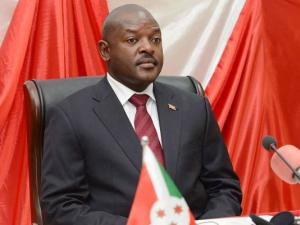
Nkurunziza, now isolated, creates crisis all by himself
Differences between political leaders and conflicting national interests have once again cropped up to threaten the integration of the East African Community member states, bringing back memories of the 1977 break-up of its precursor.
On November 30, the 20th Ordinary Meeting of the EAC heads of state ended in disarray after Burundi boycotted, angry at how its concerns had been handled by the current EAC chairman, Uganda's President Yoweri Museveni.
President Museveni was forced to call off the meeting and reschedule it to December 27 citing lack of quorum.
As the issues simmer under the surface, some observers say the Community could be staring at a repeat of 1977 due to unresolved personality clashes, commercial interests and security issues among the partner states.
In 1977, the break-up was caused by the ideological differences between Kenya and Tanzania, and personal differences between Tanzania’s Julius Nyerere and Ugandan dictator Idi Amin.
While the current EAC, revived in 1999, was supposed to be people-centred and business-driven, experts say the bloc is now at the mercy of government elites.
Challenges
They cite differences between President Paul Kagame of Rwanda and President Pierre Nkurunziza of Burundi; President Nkurunziza and President Museveni and other nationalist issues that present obstacles to smooth integration.
Harold Acemah, a retired Ugandan diplomat with 30 years experience, says the failure of the 20th Summit is a “bad omen” — a pointer to the difficulties the bloc is facing.
These include inadequate resources to finance the operations of the Community Secretariat, a lack of trust among the six heads of state and a lack of political commitment to the ideals and agreed agenda as and programmes.
“President Nkurunziza feels like a poor cousin who is taken for granted by his big brothers,” said Mr Acemah, citing the tone of last week’s correspondence between President Museveni and President Nkurunziza, after the latter requested postponement of the Summit to give his country time to prepare.
“President Museveni was abrasive and undiplomatic. It reflects bad blood between the two EAC leaders,” said Mr Acemah.
Arusha Accord
He, however, traces the emerging friction between President Nkurunziza and the other EAC leaders to his move on the Arusha Accord, when he sought a controversial third term in 2015.
It is Pierre Nkurunziza who feels isolated, not necessarily Burundi, says the diplomat.
The current situation goes against the vision of the people-driven Community.
Article 5 of the 1999 EAC Treaty says that the objectives of the Community is to develop policies and programmes aimed at deepening co-operation among the partner states in political, economic, social and cultural fields, research and technology, defence, security and legal and judicial affairs, for their mutual benefit.
But of great importance is Article 5 (3) d, which states, “The strengthening and consolidation of the long standing political, economic, social, cultural and traditional ties and associations between the peoples of the Partner States so as to promote a people-centred mutual development of these ties and associations.
Nicodemus Minde, a Tanzanian political commentator, says that the EAC, modelled along the European Union, has failed because the integration process is still elite-driven.
He says that the EAC should endeavour to use its legislative organ (the East African Legislative Assembly) to push for a people-centred integration. It has so far failed.
Mr Minde says that President Nkurunziza is still livid about the failed coup of 2015 that took place while he was attending an EAC summit in Tanzania.
His controversial third-term has also made him uncomfortable domestically, regionally and internationally.
Treaty limitations
Abubakar Zein, a former member of the East African Legislative Assembly from Kenya, said that the challenge is that the Treaty has limitations and the implementation mechanisms had been earmarked for review seven years ago but it never happened.
“For instance, how do you deal with a country like Burundi that disobeys the chair, has made it difficult for the Council of Ministers to work, and torpedoed the summit? This is because the suspension and expulsion mechanisms are yet to be fully developed,” said Mr Zein.
Mr Acemah says political will is lacking among the leaders but there is plenty of goodwill among East Africans.
He said the arrears owed to the EAC by partner states and late payments of contributions to the budget are symptoms of a lack of commitment, rather than a genuine inability to pay.
“If the EAC were people-driven, many of the tensions that are causing divisions would not arise. If challenges arose, I believe they would be manageable and easier to resolve. In many ways, East Africa has not fully recovered from the tragic collapse of the original Community in 1977,'' said Mr Acemah.
The East African Court of Justice and EALA are the only two organs that enjoy some measure of independence.
But the mandate of the court still has issues of governance and democracy and the role of civil society and the private sector has not been fully developed.
Member contribution
While the EAC has an annual budget of about $110 million, partner states are required to pay up between $10 and $12 million only and the rest is given by donors.
But it would be unfair to ask for instance, Kenya — with a bigger economy — and Burundi, whose economy is almost equivalent to that of Kenya's Kiambu County, to pay the same amount.
This means that Burundi has been defaulting on its payments and in some cases Kenya and Tanzania chip in on its behalf through a bilateral arrangement. South Sudan has the resources, but is still in political conflict.
This means that it is perpetually in financial crisis and the contributions are only used for recurrent expenditure such as salaries and not development agenda.
There have been suggestions that the bigger economies should contribute more, the same way Germany does in the European Union.
But Tanzania has resisted such an arrangement on grounds that the partner states that pay more may end up calling the shots.
Other suggestions have been to impose taxes on imports as in the African Union’s new measures, but importers have resisted more taxation.
In real time, only the Customs Union has a legal framework in the EAC Customs Union Act.
The Common Market, the Monetary Union and the Political Federation still don’t have the legal framework. This means many processes have not been implemented. The Right of Establishment and free movement of goods and people is still far away.
One of the major challenges for the EAC however is harmonising the visions of the partner states with that of the Community first and then aligning them with that of the AU.
EAC has Vision 2015, Kenya has Vision 2030, Uganda has Vision 2040, Rwanda has Vision 2020/2050, while Tanzania has Vision 2025. The AU has Vision 2063. These need to be harmonised.
